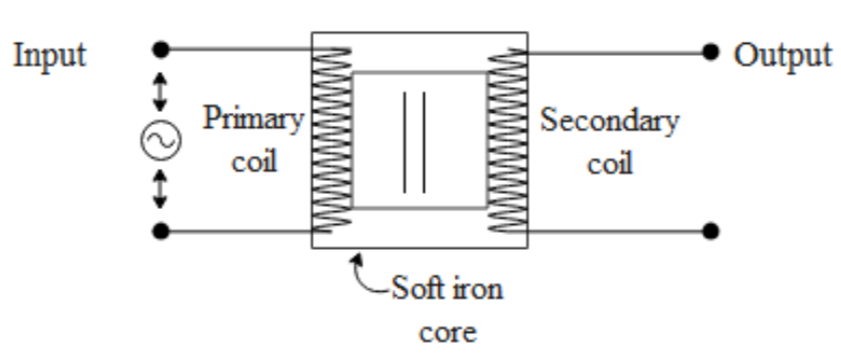
The transformer works on
a) AC only
b) DC only
c) Both AC and DC
d) AC more efficiently than DC
Answer
578.1k+ views
Hint: A transformer works on the principle of mutual induction. Mutual is the process where two coils are placed close to each other such that the changing magnetic field of one ( i.e. primary) due to the changing current gets linked to the other(i.e. secondary), then emf is induced in the second coil. From this principle, we can compare both the AC and DC and analyze whether they satisfy the criteria for mutual induction.
Complete step-by-step solution:

The above figure represents a transformer wherein the primary and the secondary coils are mutually inducted. The emf is induced in a secondary coil only if there is a changing magnetic field generated by the primary coil. The field produced by a primary coil is given by i.e. $B={{\mu }_{\circ }}ni$ where ${{\mu }_{\circ }}$ is the permeability constant, n is the number of turns in the primary and i is the current through it. The field generated can induce emf in the secondary coil if and only if the current through it keeps on changing at any given instant of time. In a DC source, the current remains constant but in an AC source the current keeps on changing. Hence a transformer will only work on AC.
Hence the correct answer is option (a).
Note: There are two types of transformers. One is a step-up transformer and the other is a step-down transformer. In the step-up transformer the voltage across the primary is less than that of the secondary coil whereas for a step-down transformer the voltage across the primary is more than that of the secondary.
Complete step-by-step solution:

The above figure represents a transformer wherein the primary and the secondary coils are mutually inducted. The emf is induced in a secondary coil only if there is a changing magnetic field generated by the primary coil. The field produced by a primary coil is given by i.e. $B={{\mu }_{\circ }}ni$ where ${{\mu }_{\circ }}$ is the permeability constant, n is the number of turns in the primary and i is the current through it. The field generated can induce emf in the secondary coil if and only if the current through it keeps on changing at any given instant of time. In a DC source, the current remains constant but in an AC source the current keeps on changing. Hence a transformer will only work on AC.
Hence the correct answer is option (a).
Note: There are two types of transformers. One is a step-up transformer and the other is a step-down transformer. In the step-up transformer the voltage across the primary is less than that of the secondary coil whereas for a step-down transformer the voltage across the primary is more than that of the secondary.
Recently Updated Pages
A man running at a speed 5 ms is viewed in the side class 12 physics CBSE

The number of solutions in x in 02pi for which sqrt class 12 maths CBSE

State and explain Hardy Weinbergs Principle class 12 biology CBSE

Write any two methods of preparation of phenol Give class 12 chemistry CBSE

Which of the following statements is wrong a Amnion class 12 biology CBSE

Differentiate between action potential and resting class 12 biology CBSE

Trending doubts
What are the major means of transport Explain each class 12 social science CBSE

Which are the Top 10 Largest Countries of the World?

Draw a labelled sketch of the human eye class 12 physics CBSE

How much time does it take to bleed after eating p class 12 biology CBSE

Explain sex determination in humans with line diag class 12 biology CBSE

Explain sex determination in humans with the help of class 12 biology CBSE




